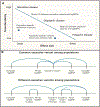The Missing Diversity in Human Genetic Studies
- PMID: 30901543
- PMCID: PMC7380073
- DOI: 10.1016/j.cell.2019.02.048
The Missing Diversity in Human Genetic Studies
Erratum in
-
The Missing Diversity in Human Genetic Studies.Cell. 2019 May 2;177(4):1080. doi: 10.1016/j.cell.2019.04.032. Cell. 2019. PMID: 31051100 No abstract available.
Abstract
The majority of studies of genetic association with disease have been performed in Europeans. This European bias has important implications for risk prediction of diseases across global populations. In this commentary, we justify the need to study more diverse populations using both empirical examples and theoretical reasoning.
Copyright © 2019. Published by Elsevier Inc.
Figures


Comment in
-
Huge US government study to offer genetic counselling.Nature. 2019 Aug;572(7771):573. doi: 10.1038/d41586-019-02509-4. Nature. 2019. PMID: 31455909 No abstract available.
-
Genomics of African American remains - limits must not compound inequity.Nature. 2021 Aug;596(7870):35. doi: 10.1038/d41586-021-02129-x. Nature. 2021. PMID: 34345046 No abstract available.
References
-
- Buxbaum J, Jacobson DR, Tagoe C, Alexander A, Kitzman DW, Greenberg B, Thaneemit-Chen S, and Lavori P (2006). Transthyretin V122I in African Americans with congestive heart failure. J. Am. Coll. Cardiol 47, 1724–1725. - PubMed
-
- Curtis D (2018). Polygenic risk score for schizophrenia is more strongly associated with ancestry than with schizophrenia. Psychiatr. Genet 28, 85–89. - PubMed
Publication types
MeSH terms
Grants and funding
LinkOut - more resources
Full Text Sources
Other Literature Sources

